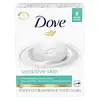What's inside
What's inside
 Key Ingredients
Key Ingredients

 Benefits
Benefits

 Concerns
Concerns

 Ingredients Side-by-side
Ingredients Side-by-side

Water
Skin ConditioningButylene Glycol
HumectantGlycerin
HumectantLinoleic Acid
Cleansing1,2-Hexanediol
Skin ConditioningCetearyl Olivate
Cetearyl Alcohol
EmollientCetyl Ethylhexanoate
EmollientPropanediol
SolventSorbitan Olivate
EmulsifyingCaprylic/Capric Triglyceride
MaskingOctyldodecanol
EmollientSynthetic Beeswax
Emulsion StabilisingColloidal Oatmeal
AbsorbentCeramide NP
Skin ConditioningCeramide Ns
Skin ConditioningCeramide AP
Skin ConditioningCeramide As
Skin ConditioningCeramide EOP
Skin ConditioningLactobacillus Ferment Lysate
Skin ConditioningSqualane
EmollientHydrolyzed Hyaluronic Acid
HumectantCalcium Chloride
AstringentArginine
MaskingMethionine
Skin ConditioningCysteine
AntioxidantLysine
Skin ConditioningLinolenic Acid
CleansingSodium Hyaluronate
HumectantHyaluronic Acid
HumectantPalmitic Acid
EmollientOleic Acid
EmollientHouttuynia Cordata Extract
Skin ConditioningMadecassoside
AntioxidantCentella Asiatica Leaf Extract
Skin ConditioningHydrogenated Lecithin
EmulsifyingArtemisia Capillaris Extract
Panthenol
Skin ConditioningSimmondsia Chinensis Seed Oil
EmollientPantolactone
HumectantHydrolyzed Malt Extract
Skin ConditioningGlyceryl Stearate
EmollientGlutamic Acid
HumectantAspartic Acid
MaskingEthylhexylglycerin
Skin ConditioningStearic Acid
CleansingHydrogenated Polyisobutene
EmollientTaraxacum Officinale Leaf Extract
Skin ConditioningHydrolyzed Gardenia Florida Extract
AntioxidantHydrolyzed Viola Tricolor Extract
Skin ProtectingPolyglyceryl-10 Laurate
Skin ConditioningSorbitan Isostearate
EmulsifyingCarbomer
Emulsion StabilisingTromethamine
BufferingPolyacrylate-13
Ethylhexyl Palmitate
EmollientPentylene Glycol
Skin ConditioningTocopherol
AntioxidantWater, Butylene Glycol, Glycerin, Linoleic Acid, 1,2-Hexanediol, Cetearyl Olivate, Cetearyl Alcohol, Cetyl Ethylhexanoate, Propanediol, Sorbitan Olivate, Caprylic/Capric Triglyceride, Octyldodecanol, Synthetic Beeswax, Colloidal Oatmeal, Ceramide NP, Ceramide Ns, Ceramide AP, Ceramide As, Ceramide EOP, Lactobacillus Ferment Lysate, Squalane, Hydrolyzed Hyaluronic Acid, Calcium Chloride, Arginine, Methionine, Cysteine, Lysine, Linolenic Acid, Sodium Hyaluronate, Hyaluronic Acid, Palmitic Acid, Oleic Acid, Houttuynia Cordata Extract, Madecassoside, Centella Asiatica Leaf Extract, Hydrogenated Lecithin, Artemisia Capillaris Extract, Panthenol, Simmondsia Chinensis Seed Oil, Pantolactone, Hydrolyzed Malt Extract, Glyceryl Stearate, Glutamic Acid, Aspartic Acid, Ethylhexylglycerin, Stearic Acid, Hydrogenated Polyisobutene, Taraxacum Officinale Leaf Extract, Hydrolyzed Gardenia Florida Extract, Hydrolyzed Viola Tricolor Extract, Polyglyceryl-10 Laurate, Sorbitan Isostearate, Carbomer, Tromethamine, Polyacrylate-13, Ethylhexyl Palmitate, Pentylene Glycol, Tocopherol
 Reviews
Reviews

Ingredients Explained
These ingredients are found in both products.
Ingredients higher up in an ingredient list are typically present in a larger amount.
Glycerin is already naturally found in your skin. It helps moisturize and protect your skin.
A study from 2016 found glycerin to be more effective as a humectant than AHAs and hyaluronic acid.
As a humectant, it helps the skin stay hydrated by pulling moisture to your skin. The low molecular weight of glycerin allows it to pull moisture into the deeper layers of your skin.
Hydrated skin improves your skin barrier; Your skin barrier helps protect against irritants and bacteria.
Glycerin has also been found to have antimicrobial and antiviral properties. Due to these properties, glycerin is often used in wound and burn treatments.
In cosmetics, glycerin is usually derived from plants such as soybean or palm. However, it can also be sourced from animals, such as tallow or animal fat.
This ingredient is organic, colorless, odorless, and non-toxic.
Glycerin is the name for this ingredient in American English. British English uses Glycerol/Glycerine.
Learn more about GlycerinStearic Acid is a fatty acid. It is an emollient, emulsifier, and texture enhancer.
As an emollient, stearic acid helps soften skin. It aids the skin's protective barrier by preventing water loss. It also provides a gentle cleansing effect without stripping away natural oils.
Stearic acid may also be used to enhance the texture of products. It can add volume and stabilize ingredients such as water and oil. This can help water and oil ingredients from separating.
Sources of stearic acid include animal or vegetable fats/oils such as coconut or shea. It can be naturally found in butter, cocoa butter, shea butter, vegetable fats, and animal tallow.
This ingredient may not be Malassezia folliculitis, or fungal-acne safe.
Learn more about Stearic AcidWater. It's the most common cosmetic ingredient of all. You'll usually see it at the top of ingredient lists, meaning that it makes up the largest part of the product.
So why is it so popular? Water most often acts as a solvent - this means that it helps dissolve other ingredients into the formulation.
You'll also recognize water as that liquid we all need to stay alive. If you see this, drink a glass of water. Stay hydrated!
Learn more about Water